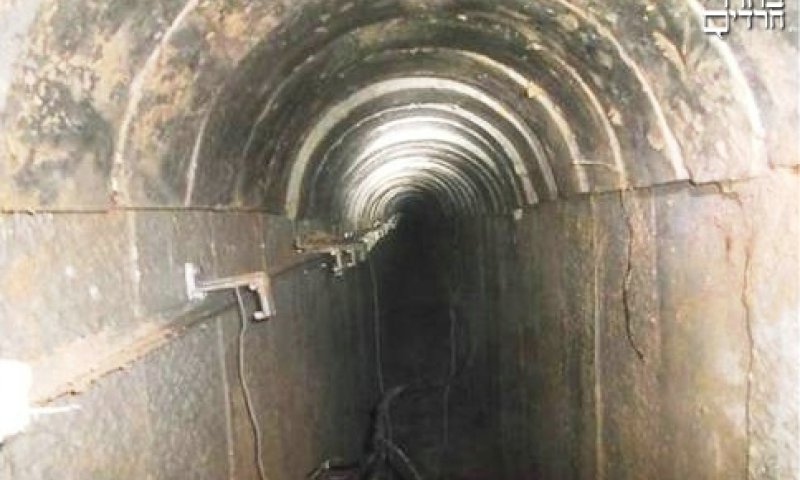
Terrorist tunnel in Gaza bombed
Terrorist tunnel bombed in Gaza • Cabinet approved: increased air strikes and limited reserve mobilization
- Eli Schlesinger, Behadrey HAredim
- י"א תמוז התשע"ד

Photo: Flash 90
In Gaza it was decided to break the rules: a heavy barrage of 30 rockets were fired from Gaza into all parts of the South, and within ten minutes alarms in an array of cities and regional councils, including Ashdod, were activated.
Alarms were activated even in areas that are not used to hearing the sirens, like Beit Shemesh, Telzstone, Rehovot and more. "Iron Dome" intercepted four rockets over Netivot.
Following the escalation and increasing the range of fire, the HFC instructed residents of Be'er Sheva, Ashdod and Ashkelon to open shelters. Since midnight about 50 rockets and mortar shells were launched, and about 200 over the last month.
HFC worsened the guidelines to residents who live within 40 miles from the Gaza Strip. According to HFC spokesperson Colonel (Ret.) Dr. Yechiel Sofer, gatherings of 500 or more are prohibited in the Gaza perimeter. Outdoor activity of summer camps for children will be permitted if it allows reaching a protected area within 15 seconds in the Gaza vicinity and within a minute in Beersheba and surroundings.
Over the last two days IDF forces have been operating in the southern Gaza Strip, and performing drilling to locate tunnels. A short while ago the IDF carried out another attack, revealing a tunnel designed to target at soldiers.
According to a senior in the IDF, the killed tonight in Gaza are Hamas members who were in a tunnel in southern Gaza intended for the attack, in which the IDF operated two days ago. According to the officer, those activists busied themselves with explosives in the tunnel at the time, and for an unclear reason they exploded and the tunnel collapsed.
"We are engaged in search and locating of all ends of the tunnel, and we continue to attack targets that are not related to tunnels," the official said.
It remains unclear when and how Hamas had planned to use the tunnel, but the officer said it was intended to attack. During the explosion tonight, there were few middle-ranking Hamas operatives in it.
In identifying the tunnel, the Cabinet approved to increase air strikes to take a toll on Hamas for the bombing which was thwarted. At the same time it ordered preparations for a ground operation when necessary. For this purpose, two Infantry Divisions were prepared: Paratroopers and Givati. At the same time, as part of the escalation it was decided to recruit limited reserves of 1,500 people, headquarters and command backs.
The military wing of the terrorist organization in Gaza reported tonight that six of its members were killed and four injured in an IDF strike in Rafah, in the southern Gaza Strip. Most likely the terrorists were killed in a tunnel, but it is unclear whether it is a smuggling or assault tunnel dug toward Israel. Another activist was killed in an attack elsewhere.
The security system clarified that the Palestinians in the tunnel were not necessarily affected as a direct result of the attacks.
Hamas spokesman in Gaza, Sami Abu Zuhari referred to the liquidation of seven members of the organization's military wing, in his Facebook page: "This is a serious escalation and the enemy will pay the price," he wrote. The danger in the tunnels
Threats in the Gaza Strip are many, and include tactical challenges - such as high trajectory fire - along with threats that are affected by geographic proximity, such as the threat of tunnels, charges and harm to forces on the security fence. To deal with these threats, intelligence officers continue to be on the alert, collecting information in order to discover the next attempt.
In recent months, major emphasis was placed on the threat of tunnels. "There is much more awareness for the threat of tunnels since the Pillar of Cloud operation - but the fact that one is more aware of it, does not indicate that it has evolved," clarified Captain A. the intelligence analysis performed continuously. "There is a preoccupation of the enemy with tunnels, and drawing conclusions in light of the mistakes it made in the tunnels exposed. This is a strategic weapon of the enemy."
Tunnels pose a threat of many dangers, such as kidnapping of a soldier (such as the case of Gilad Shalit), penetration into a settlement or exploding a tunnel. "The enemy realized that we have technological superiority over it and in terms of power, so it tries to find solutions," explained Capt. A.. "From what we exposed in the tunnel of the kidnapping of Gilad Shalit and to the tunnels we reveal today, this certainly shows development. The progress is in quantity, quality of target and quality of excavation - no doubt that this field will continue to develop."
The challenge brought by the threat of tunnels occupies the forces in the Gaza Division in southern Gaza Strip, and the engineering and intelligence forces take care to discover and eradicate the phenomenon. "It is estimated that permeability and bomb threats underground will continue to be very relevant," the intelligence officer of the Southern Division, Captain A. claimed.
Another threat which occupies the forces is a threat of charges, although since the Pillar of Cloud operation is declining. "Wherever an explosive was planted, we know that there is a charge," Captain A. said decisively, and stressed that every charge is disabled. "There is no doubt that the period after the operation allows more charges because of the understandings – if in the past the border was 300m, today it is about 100m."
Alarms were activated even in areas that are not used to hearing the sirens, like Beit Shemesh, Telzstone, Rehovot and more. "Iron Dome" intercepted four rockets over Netivot.
Following the escalation and increasing the range of fire, the HFC instructed residents of Be'er Sheva, Ashdod and Ashkelon to open shelters. Since midnight about 50 rockets and mortar shells were launched, and about 200 over the last month.
HFC worsened the guidelines to residents who live within 40 miles from the Gaza Strip. According to HFC spokesperson Colonel (Ret.) Dr. Yechiel Sofer, gatherings of 500 or more are prohibited in the Gaza perimeter. Outdoor activity of summer camps for children will be permitted if it allows reaching a protected area within 15 seconds in the Gaza vicinity and within a minute in Beersheba and surroundings.
Over the last two days IDF forces have been operating in the southern Gaza Strip, and performing drilling to locate tunnels. A short while ago the IDF carried out another attack, revealing a tunnel designed to target at soldiers.
According to a senior in the IDF, the killed tonight in Gaza are Hamas members who were in a tunnel in southern Gaza intended for the attack, in which the IDF operated two days ago. According to the officer, those activists busied themselves with explosives in the tunnel at the time, and for an unclear reason they exploded and the tunnel collapsed.
"We are engaged in search and locating of all ends of the tunnel, and we continue to attack targets that are not related to tunnels," the official said.
It remains unclear when and how Hamas had planned to use the tunnel, but the officer said it was intended to attack. During the explosion tonight, there were few middle-ranking Hamas operatives in it.
In identifying the tunnel, the Cabinet approved to increase air strikes to take a toll on Hamas for the bombing which was thwarted. At the same time it ordered preparations for a ground operation when necessary. For this purpose, two Infantry Divisions were prepared: Paratroopers and Givati. At the same time, as part of the escalation it was decided to recruit limited reserves of 1,500 people, headquarters and command backs.
The military wing of the terrorist organization in Gaza reported tonight that six of its members were killed and four injured in an IDF strike in Rafah, in the southern Gaza Strip. Most likely the terrorists were killed in a tunnel, but it is unclear whether it is a smuggling or assault tunnel dug toward Israel. Another activist was killed in an attack elsewhere.
The security system clarified that the Palestinians in the tunnel were not necessarily affected as a direct result of the attacks.
Hamas spokesman in Gaza, Sami Abu Zuhari referred to the liquidation of seven members of the organization's military wing, in his Facebook page: "This is a serious escalation and the enemy will pay the price," he wrote. The danger in the tunnels
Threats in the Gaza Strip are many, and include tactical challenges - such as high trajectory fire - along with threats that are affected by geographic proximity, such as the threat of tunnels, charges and harm to forces on the security fence. To deal with these threats, intelligence officers continue to be on the alert, collecting information in order to discover the next attempt.
In recent months, major emphasis was placed on the threat of tunnels. "There is much more awareness for the threat of tunnels since the Pillar of Cloud operation - but the fact that one is more aware of it, does not indicate that it has evolved," clarified Captain A. the intelligence analysis performed continuously. "There is a preoccupation of the enemy with tunnels, and drawing conclusions in light of the mistakes it made in the tunnels exposed. This is a strategic weapon of the enemy."
Tunnels pose a threat of many dangers, such as kidnapping of a soldier (such as the case of Gilad Shalit), penetration into a settlement or exploding a tunnel. "The enemy realized that we have technological superiority over it and in terms of power, so it tries to find solutions," explained Capt. A.. "From what we exposed in the tunnel of the kidnapping of Gilad Shalit and to the tunnels we reveal today, this certainly shows development. The progress is in quantity, quality of target and quality of excavation - no doubt that this field will continue to develop."
The challenge brought by the threat of tunnels occupies the forces in the Gaza Division in southern Gaza Strip, and the engineering and intelligence forces take care to discover and eradicate the phenomenon. "It is estimated that permeability and bomb threats underground will continue to be very relevant," the intelligence officer of the Southern Division, Captain A. claimed.
Another threat which occupies the forces is a threat of charges, although since the Pillar of Cloud operation is declining. "Wherever an explosive was planted, we know that there is a charge," Captain A. said decisively, and stressed that every charge is disabled. "There is no doubt that the period after the operation allows more charges because of the understandings – if in the past the border was 300m, today it is about 100m."
תגובות
{{ comment.number }}.
הגב לתגובה זו
{{ comment.date_parsed }}
{{ comment.num_likes }}
{{ comment.num_dislikes }}
{{ reply.date_parsed }}
{{ reply.num_likes }}
{{ reply.num_dislikes }}



הוספת תגובה
לכתבה זו טרם התפרסמו תגובות